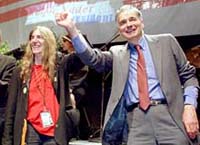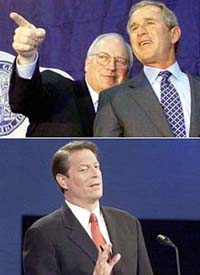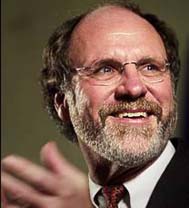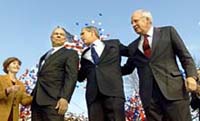
| Headlines |
| Davis Op-Ed |
| week of: |
| Sept. 27th |
| Oct. 4th |
| Oct. 11th |
| Oct. 18th |
| Oct. 25th |
| Nov. 1st |
| Nov. 8th |
| Nov. 15th |
|
The
Bush Campaign's Final Days: Character Counts |
|
||
|
|
The
Gore Campaign's Final Days: Voter Mobilization and Social Security The Gore strategy in the last days of the campaign stresses turning out the Democratic base in huge numbers - especially African-Americans and labor union members - and emphasizing Social Security above all other issues. Source: The NY Times |
||
|
Nader
Campaigns to the End source: The New York Times |
 Ralph Nader, who campaigned with the singer Patti Smith in Long Beach, Calif., on Friday, has been using his rallies to raise money. |
||
 Gov. George W. Bush's selection of Dick Cheney, top, as his running mate brought experience to the ticket but did not seem to help him politically. Vice President Al Gore's performance in the first of three televised presidential debates did not live up to his campaign's expectations. |
The
Campaign of 2000: What Each Candidate Did Right, and Wrong |
||
|
Foreign Policy Differences Between Gore and
Bush |
 Wax models made ahead of the election day |
||

Democratic New Jersey senate candidate John Corzine |
Jon
Corzine Sets Record for Self-Financed Campaign Democratic candidate Jon Corzine will spend more than $60 million of his own money on his campaign for the Senate in New Jersey. What activities has Corzine used his money for? How has his self-financed campaign helped Democrats running for the House and Senate in other states? Source: MSNBC |
||
|
Who
Would Serve in the Bush and the Gore Cabinets? Source: The washington post |
The
Supreme Court in the Presidential Election It is likely that the man elected President will appoint at least three justices to the Supreme Court over the next four years. The opportunity to reshape the Court will give the new President influence over the Court for many more years than the next presidential term. Source: The Washington Post |
||
| The
Federal Bureaucracy in the Presidential Election The presidential candidates differ substantially on issues related to the role of government in regulating the economy. The priorities pursued by federal agencies on antitrust, health and safety, and other regulatory programs would be very different under a Gore Administration than under a Bush Administration. Source: The Washington post |
David
Broder's Campaign Analysis A staple of campaign coverage since the 1960s has been Washington Post political columnist David Broder's 50-state analysis of the campaign, which traditionally appears on the Sunday before Election Day. Read Broder's projections for the campaigns for President, House, and Senate. Source: The Washington post |
||
|
Other Stories: Op Ed piece for Nov. 8th Election Projections Sunday, November 5, 2000 I am projecting that George W. Bush will win a narrow popular and electoral vote majority, and that the Republicans will maintain control of both the House and the Senate by the narrowest of margins. My final electoral vote projection has Bush at 279 and Gore at 259. In the popular vote, I would give Bush 49 percent, Gore 47 percent, Nader 3 percent, Buchanan and others 1 percent. Here is how I line up the states by region, with the number of electoral votes for each candidate in each region: New England: Gore wins Connecticut, Maine, Massachusetts, New Hampshire, Rhode Island, and Vermont. Gore 35, Bush 0. Mid-Atlantic: Gore wins Delaware, the District of Columbia, Maryland, New Jersey, New York, and Pennsylvania. Bush wins West Virginia. Gore 87, Bush 5. South: Gore wins Florida and Tennessee. Bush wins Alabama, Arkansas, Georgia, Kentucky, Louisiana, Mississippi, North Carolina, Oklahoma, South Carolina, Texas, and Virginia. Bush 127, Gore 36. Midwest: Gore wins Illinois and Minnesota. Bush wins Indiana, Iowa, Kansas, Michigan, Missouri, Nebraska, North Dakota, Ohio, South Dakota, and Wisconsin. Bush 97, Gore 32. Mountain States: Bush wins Arizona, Colorado, Idaho, Montana, Nevada, New Mexico, Utah, and Wyoming. Bush 40, Gore 0. Pacific: Gore wins California, Hawaii, and Washington. Bush wins Alaska and Oregon. Gore 69, Bush 10. My final Senate projection has the Republicans with a 52 to 48 majority, down from 54 to 46 currently. Here is my Senate summary: Republicans re-elected (15): Abraham (MI), Ashcroft (MO), Burns (MT), Chafee (RI), DeWine (OH), Frist (TN), Hatch (UT), Hutchison (TX), Jeffords (VT), Kyl (AZ), Lott (MS), Lugar (IN), Santorum (PA), Snowe (ME), Thomas (WY). Republicans who beat Democratic incumbents (1): Allen (VA), defeating Robb. Republicans who win formerly Democratic open seats (1): Ensign (NV) Democrats re-elected (10): Akaka (HI), Bingaman (NM), Byrd (WV), Conrad (ND), Lieberman (CT), Feinstein (CA), Kennedy (MA), Kohl (WI), Miller (GA), Sarbanes (MD). Democrats who hold open seats (3): Clinton (NY), Corzine (NJ), Nelson (NE) Democrats who win formerly Republican open seats (1): Nelson (FL) Democrats who beat Republican incumbents (3): Cantwell (WA), defeating Gorton; Carper (DE), defeating Roth; Dayton (MN), defeating Grams. My final House projection has 219 Republicans, 214 Democrats, and 2 independents (one of whom votes with the Republicans on organizational matters, one of whom votes with the Democrats). This is a gain for the Democrats of 4 seats, not large enough for them to win control of the House. During Wednesday evening's Webcast, I will discuss these projections in light of the actual election results.
|
|||
|
|
|||

